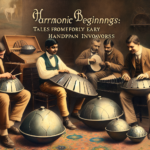<!DOCTYPE html>
<html lang="en">
<head>
<meta charset="UTF-8">
<meta name="viewport" content="width=device-width, initial-scale=1.0">
<title>Therapeutic Tones: The Healing Power of Handpan Dynamics</title>
<style>
body {
font-family: Arial, sans-serif;
line-height: 1.6;
margin: 20px;
color: #333;
}
header, main, section, footer {
max-width: 800px;
margin: 0 auto;
}
h1, h2, h3 {
margin-top: 20px;
color: #555;
}
</style>
</head>
<body>
<header>
<h1>Therapeutic Tones: The Healing Power of Handpan Dynamics</h1>
</header>
<main>
<section>
<h2>Introduction to the Handpan</h2>
<p>
The handpan, a mesmerizing percussion instrument, has captivated musicians and listeners alike with its ethereal sound. Originating in the early 2000s, this unique instrument combines the features of a steel drum and a gong, resulting in a melodic and harmonic resonance that invites introspection and emotional release. Unlike many traditional instruments, the handpan is not only about the music it produces but also about the holistic, almost spiritual experience it offers. As more people discover this instrument, its potential for therapeutic use has become a topic of intrigue.
</p>
</section>
<section>
<h2>The Anatomy of a Handpan</h2>
<p>
Understanding the physical structure of the handpan is crucial to appreciating its dynamics. Typically, a handpan consists of two steel hemispheres that are glued together, with each hemisphere incorporating a series of tuned notes. The upper part features a central note and several tone fields arranged around it. When struck gently, these fields produce tonal vibrations that resonate through the steel, creating a sound that can range from tranquil and soothing to upbeat and energizing.
</p>
<p>
Each handpan is typically tuned to a specific scale, providing a unique set of harmonic possibilities. Musicians favor pentatonic scales for their versatility and meditative qualities. The choice of materials and craftsmanship play significant roles in the sound quality, ensuring that every handpan offers an individual tonal character.
</p>
</section>
<section>
<h2>The Healing Potential of Handpan Music</h2>
<p>
At the intersection of music therapy and meditation, the handpan has gained recognition for its healing properties. Its sound induces a state of relaxation that can help to alleviate anxiety, stress, and even physical pain. The instrument’s capacity to resonate at both high and low frequencies can be particularly beneficial in therapeutic settings.
</p>
<p>
The repetitive, soothing patterns typical of handpan music help create an environment conducive to mindfulness and emotional depth. Listeners often report feelings of calm and introspection, making the instrument ideal for meditative practices. Additionally, the act of playing the handpan itself has been noted to reduce stress, improve mood, and enhance focus and overall mental clarity. This has led to its increasing use in music therapy sessions, yoga classes, and even sound bath therapies.
</p>
</section>
<section>
<h2>Exploring Handpan Dynamics</h2>
<p>
The dynamic range of the handpan is another factor contributing to its therapeutic power. Dynamics refer to the volume of sound, which can be manipulated to express different emotions and evoke responses from the listener. The handpan allows for subtle variations in dynamics, making it an expressive tool in hands of both novice and professional musicians alike.
</p>
<p>
Soft and light touches can generate gentle sounds that promote relaxation and introspection, while more forceful strikes can produce vibrant and powerful notes that energize and invigorate. This dynamic flexibility is why the handpan can transform the atmosphere of a room, adapt to the player's emotional state, and cater to the specific therapeutic needs of the audience.
</p>
</section>
<section>
<h2>Integrating Handpan Music in Therapeutic Practices</h2>
<p>
With its growing reputation as an instrument of healing, the handpan is being increasingly integrated into various therapeutic settings. Music therapists are exploring ways to incorporate its unique soundscapes into practices aimed at tackling mental health issues, enhancing emotional well-being, and promoting holistic healing.
</p>
<p>
In clinical settings, handpan music serves as a tool for relaxation and anxiety reduction. Therapists may use handpan sessions to help patients connect with their emotions, facilitating breakthroughs in counseling or therapy. Moreover, the communal aspect of handpan playing can enhance group therapy sessions, fostering a sense of shared experience and empathy among participants.
</p>
</section>
<section>
<h2>The Future of Handpan in Therapeutic Modalities</h2>
<p>
As research continues into music therapy, the role of handpans is expected to expand. The rise of interest in holistic and alternative medicine has set the stage for the handpan to become a staple in wellness centers, meditation spaces, and therapeutic environments worldwide.
</p>
<p>
Innovation in handpan design and technology may lead to new developments that enhance its therapeutic applications. Collaborations between musicians, therapists, and researchers could lead to comprehensive healing programs harnessing the full potential of handpan dynamics. The future looks promising for this instrument, as it has the potential to change how we approach mental health and well-being through the power of sound.
</p>
</section>
<section>
<h2>Conclusion</h2>
<p>
The handpan is more than an instrument—it is a bridge to a world where sound transforms into a therapeutic agent, catalyzing healing, introspection, and emotional release. Its capacity to invoke tranquility and clarity, combined with its dynamic expressiveness, makes it a powerful tool in the sphere of music therapy. As we continue to explore its dynamics and expand its potential applications, the handpan stands as a testament to the profound impact that music can have on human health and happiness.
</p>
</section>
<section>
<h2>FAQs</h2>
<h3>1. What is a handpan?</h3>
<p>
A handpan is a percussion instrument made from steel, characterized by its dome-like shape and unique, melodic sound. It consists of two hemispheres that create a resonant, harmonic tone when played.
</p>
<h3>2. How does the handpan help with relaxation?</h3>
<p>
The soothing sound of the handpan is thought to induce a meditative state, reducing stress and promoting relaxation by interacting with the brain’s frequency and inducing a calming effect on the listener.
</p>
<h3>3. Can anyone learn to play the handpan, or does it require musical training?</h3>
<p>
While musical training can enhance one's ability to play the handpan, it is highly accessible to beginners due to its intuitive layout. Many people find it easy to produce pleasing sounds even without prior musical experience.
</p>
<h3>4. What scales are commonly used in handpans?</h3>
<p>
Handpans typically utilize scales like the pentatonic because of their harmonious and peaceful sound. Each handpan is tuned to a specific scale, offering unique tonal possibilities and emotional expressions.
</p>
<h3>5. Where can I experience a handpan session?</h3>
<p>
Handpan sessions can be experienced at music therapy clinics, wellness centers, yoga studios, or specific workshops focused on therapeutic music. You can also find numerous online resources and performances to explore this fascinating instrument.
</p>
</section>
</main>
<footer>
<p>© 2023 Therapeutic Tones. All rights reserved.</p>
</footer>
</body>
</html>Therapeutic Tones: The Healing Power of Handpan Dynamics

Leave a comment




